E. Roberts
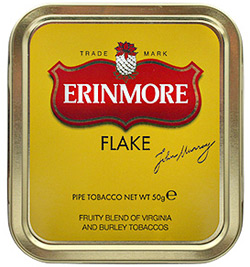 Recently here at PipesMagazine.com the focus has been on blends with long and storied, if rather peripatetic, histories. In keeping with this trend, this month’s review will put two more classics to the test—hot blondes replete with red lipstick. I speak, of course, of the two incarnations of the erstwhile Murray’s marque available on this side of the pond: the Erinmores Flake and Mixture. The recipe for Erinmore was originally created in the early 1920s at the Murrays factory in Belfast, Ireland. Purportedly several individuals including the company chemist, who is referred to by the flamboyantly Irish moniker of Daddy Burns, conceived the blend and its unique top dressing. The recipe remains a secret entrusted to only one person in a generation, at least according to company legend. Similar to the cloak-and-dagger documentation unearthed by Kevin’s investigative report on the recent Three Nuns, this is what Brian Mallen, Managing Director at the factory in the mid-90s, had to say about the recipe:
Recently here at PipesMagazine.com the focus has been on blends with long and storied, if rather peripatetic, histories. In keeping with this trend, this month’s review will put two more classics to the test—hot blondes replete with red lipstick. I speak, of course, of the two incarnations of the erstwhile Murray’s marque available on this side of the pond: the Erinmores Flake and Mixture. The recipe for Erinmore was originally created in the early 1920s at the Murrays factory in Belfast, Ireland. Purportedly several individuals including the company chemist, who is referred to by the flamboyantly Irish moniker of Daddy Burns, conceived the blend and its unique top dressing. The recipe remains a secret entrusted to only one person in a generation, at least according to company legend. Similar to the cloak-and-dagger documentation unearthed by Kevin’s investigative report on the recent Three Nuns, this is what Brian Mallen, Managing Director at the factory in the mid-90s, had to say about the recipe:
"Lots of people in the factory are involved in making the Erinmore flavour, but they’re not making it up from containers with full chemical names on them. All the products are brought under code names from a number of manufacturers, so no one manufacturer is making all the elements for Erinmore. The key to those codes I have. But there has to be a back-up, so in a locked vault in a bank in Belfast there are a number of files covering the manufacture of that particular unique flavour—if I walk under a bus someone can have access to it."

Whitehall Tobacco Works, Linfield Road, Belfast, as it stood in 2005.
© Copyright Brian Shaw and licensed for reuse under this Creative Commons License
Any agricultural product will of course vary from batch to batch, year to year, due to the fluctuating availability and flavor of leaf. Additionally, the ecosystem of commerce leads to companies being bought, sold and absorbed into larger entities; as brands change hands, they also seem to have a tendency to change recipes, at least on occasion. By all available accounts of my research, though, the recipe for the singular taste and aroma profile associated with Erinmore has remained consistent throughout its nearly 100-year span of production. Beginning with the Murray’s product, which became their flagship brand, it endured through 2005-2007 when Orlik absorbed that blending house and continued production of their blends, which included many of the Dunhill stable of brands. Now a property of the behemoth Scandinavian Tobacco Group, it is produced in Denmark, still at the Orlik factory. For more information see the video tour of the factory that Kevin took with SmokingPipes.com’s Sykes Wilford a couple of years ago.
But back to Erinmore and that signature topping. What is it? A common misnomer is that it’s pineapple, owing to the prominently displayed image of one in the Erinmore shield logo, and perhaps the bright yellow field of the label. Another quite common association is to Juicy Fruit gum, a candy that has enjoyed a similar longevity in the market, being introduced in 1893. This was a rumor I’d hoped to dispel with this review. However, when comparing the gum to the tobacco, I was impressed by the similarities in the aromatic notes, and must concede that more than a passing resemblance exists. The Wrigley Company is equally tight-lipped about the characteristic flavoring of their product, declining to comment for this reporter. Digging a little further, and enlisting the help of a chemist friend with a wine tasting kit, we agreed that isoamyl acetate—a food flavoring agent used to evoke banana or pear—is a likely culprit for producing that juicy, slightly floral top note for which Erinmore is known. For the purposes of this review, we’ll compare the flake and mixture preparations of the current production only, not wishing to wade into the waters of historical analysis.
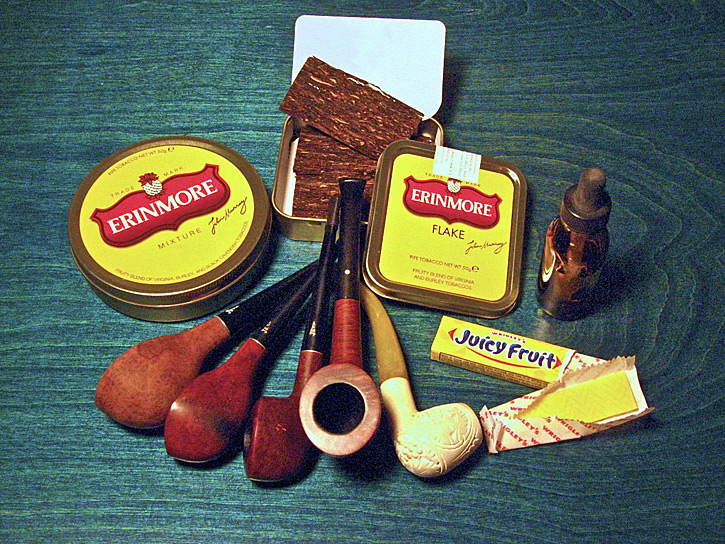
Two hot blondes, a pack of gum and a bottle of (technically speaking) booze. It’s a party!
Tin: Once opened, the bright fruity essence expands from the tin and envelopes one with the jubilant aroma. It is quite unmistakable, and can be polarizing amongst pipe smokers—many fall stolidly to one extreme of either loving or hating it. Personally enjoying quality aromatics, it was love at first light for me. The Flake, in its compact rectangular tin, is the more regal of the presentations; peeling back the gold sticker and unfolding the waxed paper wrapping reveals two dozen dark brown sticks, flecked with brighter leaf, each measuring 1/16″ by 1-1/2″ by 2-7/8″, all stacked rather precisely and awaiting your preferred preparation. The Mixture, which adds Turkish Samsun leaf to the recipe, presents as a predominantly lighter brown flecked with black bits in a comfortably loose ribbon, and with a slightly hushed version of the top note. Mixture also mentions a vanilla flavoring on the tin, and it is noticeable alongside the fruit. The iconic gold and crimson tin art is a worthy update to the historical incarnations of the logo, with John Murray’s signature added in recent years.
Char: The charring light evinces the biggest hit of the fruity topping, which commingles superbly with the bright and orange Virginias. While apparent throughout the smoke, it calms considerably after the char, where the tobaccos’ natural sweetness dominates. The flake tends toward being a bit more moist, and demands a bit of experience on the smoker’s part; suited best for tallish, slightly conical chambers when folded, it takes a few charring lights and rests to attain a good working ember, but when that’s achieved it holds the ember quite well. Mixture is at perfect moisture to pack straight from the tin, and nearly obviates the need for a charring light.
Top: Very similar to another of Orlik’s flakes, Golden Sliced, the Virginias in Erinmore Flake are the star of the show. Slight and sweet with a cool, easy burn tempered by the burley they’re pressed with, they immediately produce a good quantity of fragrant smoke. The topping is thorough, but not necessarily overpowering; a very British style aromatic, it enhances and amplifies notes already in the leaf, adding a few of its own. Not an overly complex smoke, the flavors are all explicit and well balanced, and certainly captivatingly sweet—apart from the Juicy Fruit association, individual nuances are clearly of pear, citrus, honeysuckle and even the sharply tart taste of lychee. The Mixture is a shade more muted, yet a shade more complex, and lends a delectable seasoning with the Samsun which calls to mind spiced apple cider, readily available in this season and making a great beverage accompaniment.
Mid: The pressing adds a good depth to the Flake, sustaining it through a tasty midbowl. The Mixture relies on its slightly more structured blend to carry it through, which it does equally well. Neither has a tendency to bite with calm cadence, and both produce quite a good volume of fragrant smoke which retains hints of the floral and fruity flavor, appealing to bystanders. The topping, though greatly muted after the top of the bowl, remains like honey on the palate in the aftertaste and consistently discernible in the retrohale. With tighter draft holes there is some tendency to gurgle, obviated with a change of instrument.
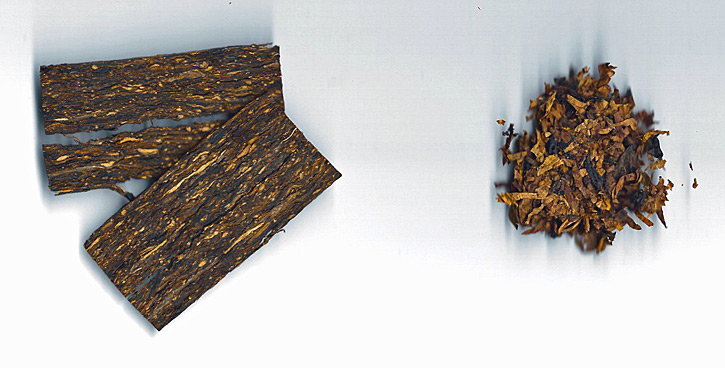
Comparing the flake to the loose ribbon reveals subtle differences.
Finish: While I wouldn’t dismiss the Erinmores as one-note smokes, they don’t exhibit a dynamic interplay or changing nuance of flavor. Their strength is in the consistency of flavor through to the heel, and they both perform quite admirably down to the ash. Both show a steady curve from the bright top to a gradually deepening bottom, all while maintaining the pleasant sweetness apparent from the tin. Overall they are both satisfying medium-bodied smokes with a good apportioning of nicotine, tart enough to sate one’s sweet tooth. Though not as thoroughly floral as true Lakeland style tobaccos, Erinmore will definitely leave its trademark ghost in a pipe; dedicated aromatic pipes are recommended.
Room Note: A good volume of smoke that carries a fair intimation of the fruity flavor the pipe smoker enjoys. I would classify this as a crowd-pleaser for those who enjoy the aroma of a pipe, and one that is singular enough to be strongly associated with memories.
Rating: 87 Flake / 84 Mixture
Erinmore Flake scores huge points for presentation; few tobaccos look and smell so inviting, and such care is apparent in its packaging that it speaks elegantly of the contents. Additionally, the Flake is a classy tobacco to pull out and prepare in a crowd. I’ll award a perfect score here, aromatic haters notwithstanding—a 15 out of 15. Erinmore Mixture, similarly garbed though marginally less regal, earns a 14.
The flake presentation is a personal favorite, and Orlik really knows how to make them. Thin, precise and consistent, and remarkably easy to fold and stuff (particularly in smaller-sized bowls, which suit this blend best), the draw and burn is perfect for the experienced flake smoker to elicit the full flavor of the blend—34 out of 35. Mixture earns accolades for good straight-from-the-tin moisture content, an effortless light and easily managed ember—again, 34 points for the draw and burn scoring.
The Erinmores have a timeless, unique flavor that aromatic smokers can appreciate. It has endured for nearly a century, and should do well into the next. While singular for its flavor + aroma profile, it is an experience with limited depth and breadth, so I cannot score as highly here. The nicotine content is comfortable, even a bit strong for the genre, and satisfying. After much deliberation, I’ll settle on a finely shaded 38 for Flake and a 36 for Mixture, which speaks to my own preferences of course.
Cellar or Smoke?
A confirmed aromatic fan, Erinmore has been a favorite of mine since I first tried it several years ago, and I maintain a few tins in the cellar for when the mood strikes. While not necessarily destined for aging, I always make sure to have some on hand, for there is really no comparable blend when one desires its unique flavor profile. The square tins of the Flake are not ideal for longer term storage, and never seem to last more than a year in any case; the round tins of Mixture, though, with its solid structure and Oriental component, should do well for more extended periods.
Brand: Erinmore
Blends: Erinmore Flake / Erinmore Mixture
Blender: STG
Type: Aromatic
Country: Denmark
Cut: Flake / Ribbon
Tobaccos: Virginia, Burley, Cavendish (Mixture also lists Samsun)
Strength: Medium
Room Note: Medium, slightly floral
Tin Size: 50g
Tin Age: Fresh – 1 year
Tin Descriptions-
Flake: The leaf tobaccos for Erinmore are selected from only premium tobacco growing regions of the world. The blend consists of mature Virginia, mellow Burley and sweet dark air cured tobaccos. It is pressed into cakes, aged and cut into slices providing a mellow and cool smoke with a flowery and fruity note.
Mixture: A subtle mix of Danish Dark Cavendish, Burley and Virginia enriched with matured Samsun from Turkey. Vanilla flavours create the soft sweetness and fruity character of the blend. Rich in contrast and with a perfect balance of aroma.
SPONSORED LINK: Erinmore Pipe Tobacco Blends – Click Here to Order Now!









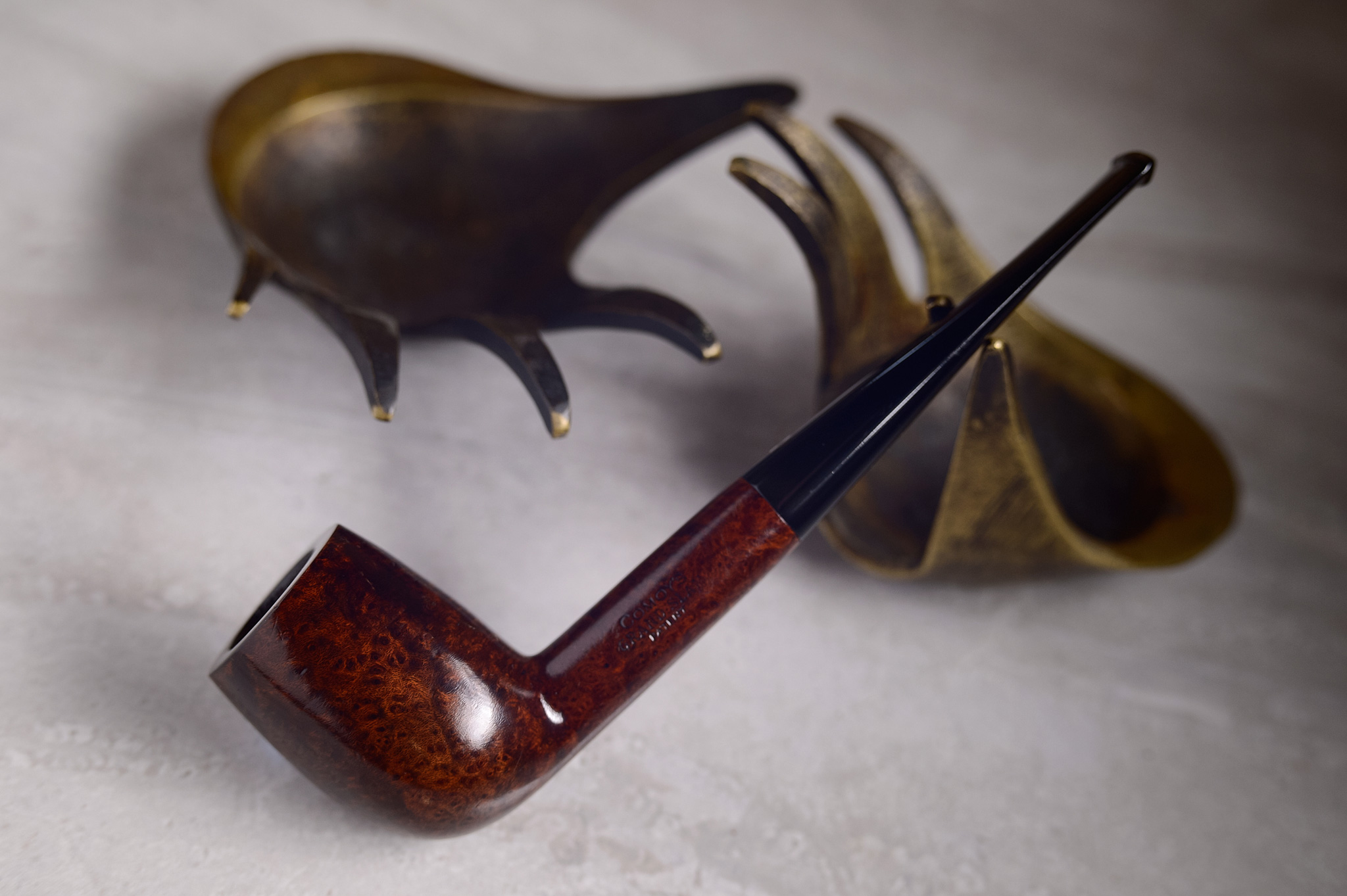


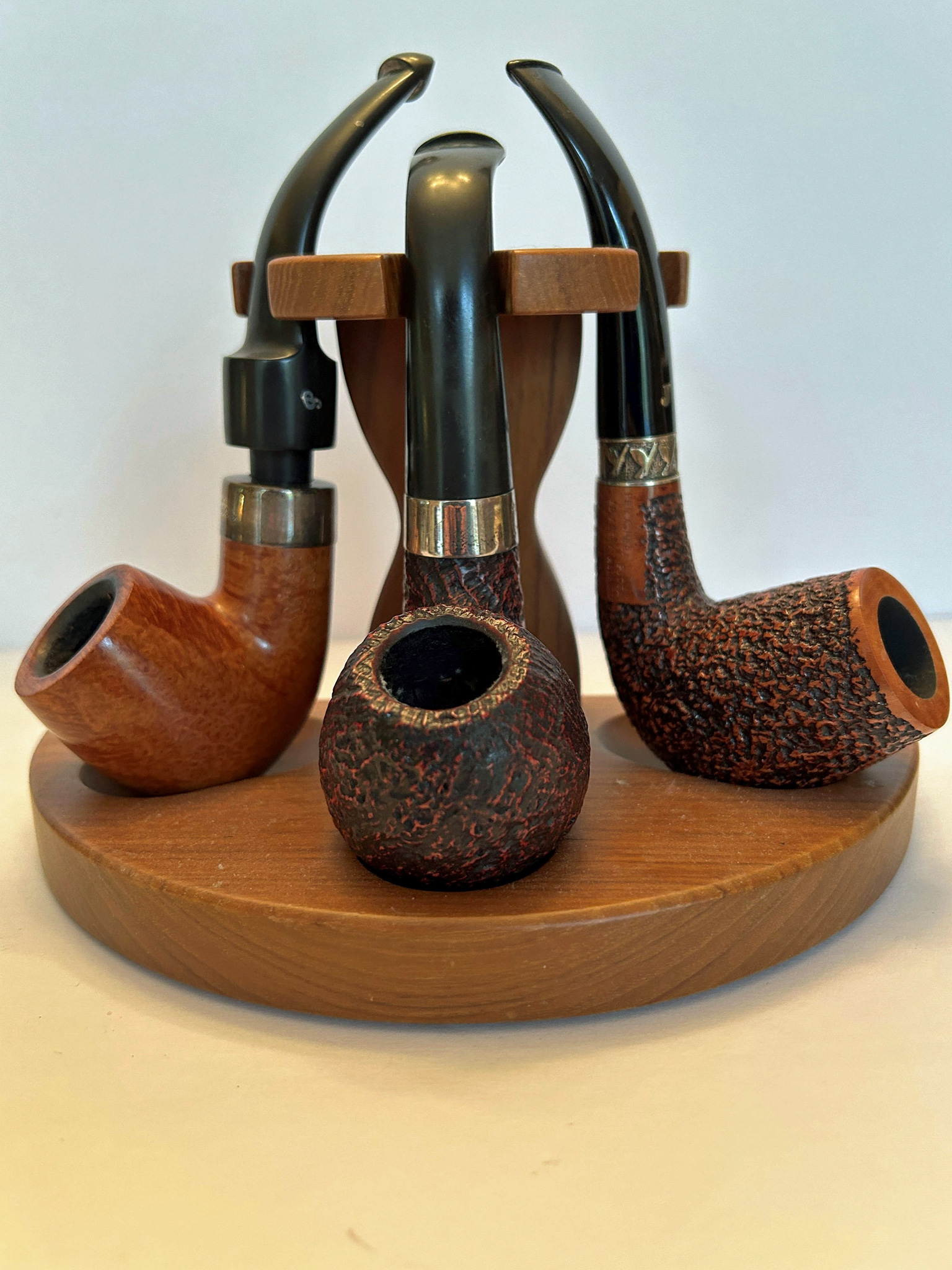





Had to pack a flake in honor of this enjoyable article. I also watched the videos for the first time today and they were great!
Fascinating. I love Erinmore Flake. Being from Belfast I pass the old factory regularly. Now a modern office block with the familiar facade of yester year. What price progress?
I enjoyed this article.
I cellar the current version of Erinmore Flake and I have smoked the original Murray version (I have a sealed tin of that as well). The original is quite different than the current version, with the former being a full Lakeland and the latter more of a fruity blend as described, almost, but not quite, an aromatic.
As for the Erinmore Mixture, I smoked some of it, but didn’t care for it at all. It’s not like the flake.
I can’t see why Erinmore flake wouldn’t improve with time, it is a Va forward flake. I currently have both of them but haven’t got around to trying them yet, I think the springtime will be a good time of the year for them. I bought both of the mixture and the flake because one of the patients I was taking care of at the hospital told me he used to smoke erimore and the smell drove the women wild.
I have both of these in my cellar, and have not tried them yet. Looks like it’s time to give them both a try. Thank you for the review.
Another fine review. Thanks for this. I had the flake for the first time a few months ago an, to my surprise, thoroughly enjoyed it. I had been put off by the reference to Juicy Fruit but found that it is an elegant smoke. Me think it is time for another tin of flake.
Well done, sir.
Just about a week ago I finished my first tin ever of the Flake. I’ve been a bulk-smoker for years, but have been trying tins for the better part of half a year now. Erinmore Flake has been my fave tin so far.
I used to smoke the flake when I first started smoking, liked it just fine but somehow stopped smoking it. I bought it again a few years back, was unimpressed and put it down again, but I don’t feel I really gave it a chance.
Nice review, Bill.
FWIW… my review of Erinmore from a “luxury tobacco review” website…
Erinmore and more!
Erinmore flake is my all-day tobacco. I can’t help but get a bit of tongue burn with Erinmore flake as I smoke deeper and faster than any sensible pipe smoker would dare enjoy what is essentially a good Virginia. The topping has a slightly sweet taste and aroma but it’s there in reserve and nowhere near the “Juicy Fruit” flavour I have heard other describe it.
Upon opening the tin, one is greeted by the pleasant aroma of earthy Virginia tobacco and a sweet and mellow odour of slightly over ripe fruit and faint whiffs of raisins & plums, but not such that one would wrinkle the nose and pull faces.
After gently peeling up the golden sticker that holds the paper lining together, one is greeted by deep browns with contrasting specks of bright yellow and medium browns.
The flakes in my tin were just right moisture-wise. I used the fold and stuff method in a new(ish) meerschaum and the taste throughout was exceptional. From false light to grey ash sans dottle, the character of this tobacco remained constant.
The only hiccup I experienced was when I pushed as wee bit too much a minor scorching of the tongue burn occurred (which as I stated was my own fault). When left to cool back down to a more manageable temperature, the first few puffs had a slight ammonia odour that disappeared once the fabulous flake forgave its abuser. By the end of a large bowl, I did feel Lady Nicotine’s abundant blessing manifested by a peaceful aura only She can bestow but it was nowhere near the rush that one receives from say Peterson Irish Flake .
I have also tried Erinmore mixture which although is the same blend seems milder in taste, aroma and a lighter room note so should anyone find that Erinmore Flake is a bit much for them, I would whole heartedly recommend the non-flake Erinmore.
Simply put, for me this is one of the few tobacco blends that I could smoke all day long!
Great review, Icloud! I take special care to avoid other people’s reviews in preparation for writing my own, and am always impressed when I find I’ve picked out a lot of the notes that others describe.
.
@andrew–I’m not implying it *won’t* improve with age; rather I’m saying that 1) the square tins should be transferred to air-tight containers for long term storage, and 2) with recent experience with an early 90s tin, I can vouch for the Virginias having legs but the aromatic component being dissipated rather quickly after some age. The 90s tin was a lovely smoke, and it had been jarred, but the aromatic sweetness remained mostly as a hint of its fresh expression.
.
@lincolnsbark – glad you checked out the videos! They’re a spectacular behind-the-scenes view thanks to PipesMagazine, and some of the finest content available here (in addition to my own articles, of course :D)
Hi everyone, (Takes a big deep breath, girds his loins and says….)
I’m not a pipesmoker, I’ve popped by to ask some expert advice if that’s ok.
My grandfather was an inveterate pipe smoker, and his preferred brand was always Erinmore Flake (I never, in 20 years saw him with anything else on his mantelpiece), but I have a bit of memory dissonance that I need to sort out.
I’m in my sixties now, but I always remember his Erinmore came in a yellow light cardboard box with individual flakes of tobacco stacked one on top of the other, much like the way chewing gum is stacked (but without the wrapping – all the flakes were seperate, the box fitted the flake for size).
Am I off the mark here, and some poetic license has crept in over the years? Was it ever presented in a small box? He never used a tin, but did have a wooden jar by his favourite chair that held his tobacco.
Why do I ask?
I’ve been given some personal papers of his from the first world war and in one letter he mentions coming across a tin of tobacco hidden in a dugout vacated by the retreating Germans.
It was not named but he does say “my officer says it’s famous, really one of the best, and it’s certainly stronger than my usual (please send more when you can), but we shared it around between us and got nine pipes from it.” etc.
Am I right in thinking that ‘his usual’ at that time wouldn’t have been Erinmore as this article says it was first produced just after WW1?
And I know it’s a tall order, but could anyone throw any light on the possible identity of what could have been ‘one of the best’ German tobaccos available in 1917?
Sorry to bang on, but I do hope you can help.
notimetoulouse- You’d be better off posting those questions in the forum section of this website, where more people will see it. Very interesting questions you have. Good luck.